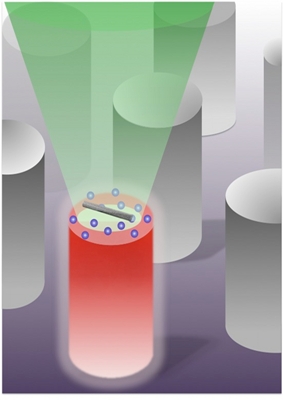A theory describing the growth of a nanotube proposed by Boris Yakobson from Rice University has been corroborated experimentally by the Air Force Research Laboratory located in Dayton, Ohio.
 By learning to grow and measure single nanotubes, scientists at the Air Force Research Laboratory were able to confirm a theory by Rice Professor Boris Yakobson that predicted the chirality of a nanotube – its "DNA code" – controls the speed of its growth. (Credit: Rahul Rao/Air Force Research Laboratory)
By learning to grow and measure single nanotubes, scientists at the Air Force Research Laboratory were able to confirm a theory by Rice Professor Boris Yakobson that predicted the chirality of a nanotube – its "DNA code" – controls the speed of its growth. (Credit: Rahul Rao/Air Force Research Laboratory)
According to the dislocation theory, a nanotube’s growth rate is controlled by its chirality or angle of growth, and armchair nanotubes are the fastest growing nanotubes. The experimental work will help in understanding the parameters called ‘DNA code of nanotubes’ by Yakobson that determine the chirality of nanotubes and thus their mechanical, optical and electrical properties. The objective of the nanoscale work is to develop the capability to produce nanotubes with particular properties.
The rolling direction of carbon atoms of a single-walled nanotube determines its chirality. Honda Research Institute’s Rahul Rao, who served at Air Force Research Laboratory, devised a method in the laboratory of Benji Maruyama, who serves as a senior researcher at Air Force Research Laboratory, to quantify the growth rates of single nanotubes.
In this technique, accurately controlled lasers are made to fire on catalyst nanoparticles that are mounted on tiny silicon pillars. The laser heat activates the nanomaterials to grow through chemical vapor deposition. The researchers simultaneously measured the growth rates of nanotubes using Ramon spectroscopy. The spectra helped them to determine the growth rate of the nanotube and the point at which its growth is terminated.
Using electron microscopy, the researchers verified that the spectra were caused by individual single-walled nanotubes. They also determined the chiral angles by comparing nanotube diameters and post-growth Raman spectra to the Kataura plot, which charts chirality based on diameter and band gap. These findings are helpful in developing particular types of nanotubes.